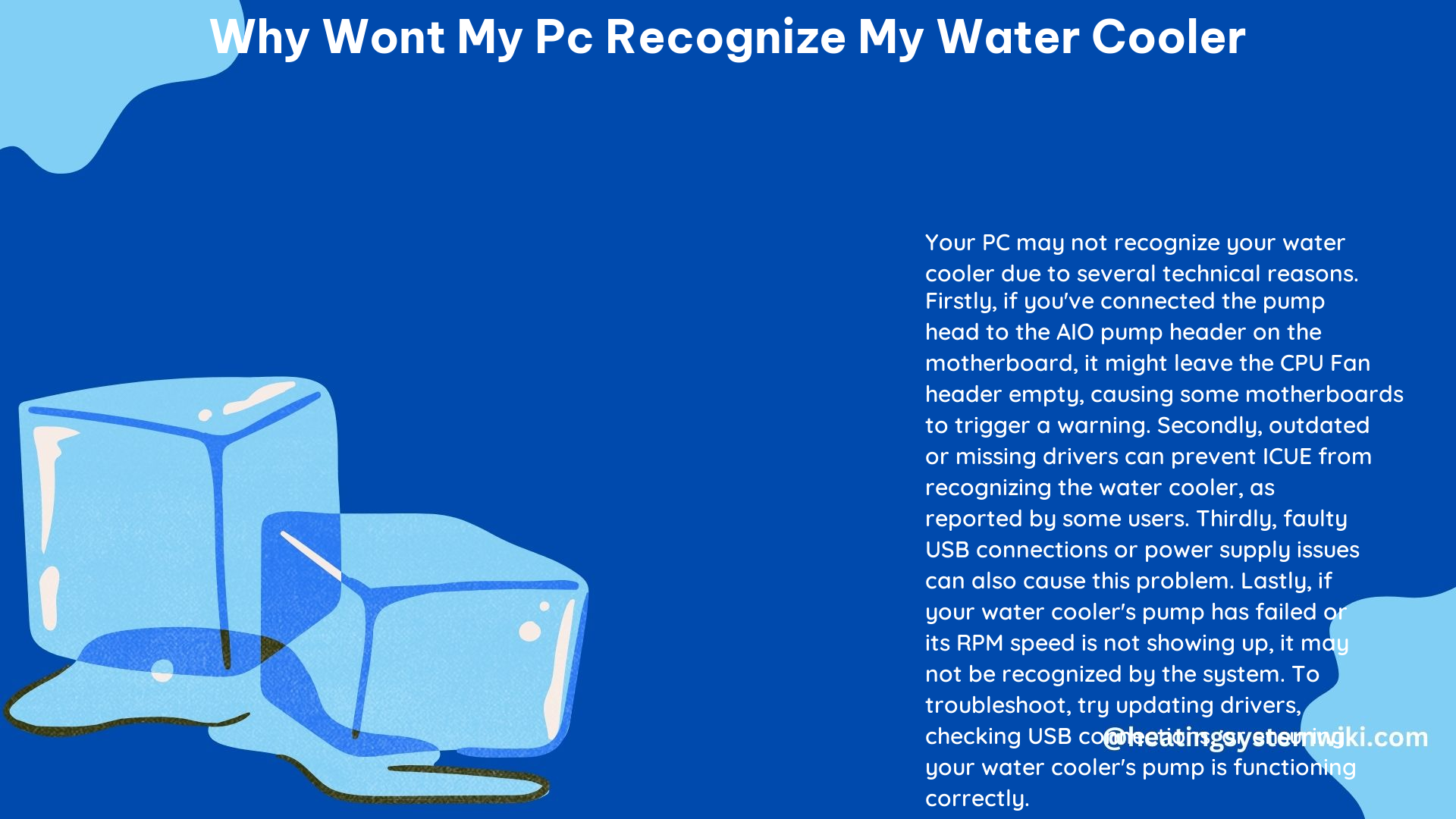When your PC fails to recognize your water cooler, it can be a frustrating experience that can lead to overheating and potential damage to your system. This comprehensive guide will delve into the common causes of this issue and provide you with a step-by-step troubleshooting process to get your water cooler up and running again.
Identifying the Problem: Pump RPM and Q-Fan Control
The user in the scenario is experiencing a specific issue with their Corsair H80i V2 Hydro Series High Performance CPU Cooler. The problem is that the pump RPM is not showing up in the BIOS, and the Q-Fan control is locked. This indicates a likely failure of the water cooler’s pump, as the lack of RPM speed is a clear sign of a malfunctioning component.
Troubleshooting Cable Connections

One of the first steps in resolving this issue is to ensure that the water cooler’s cables are properly connected to the motherboard. Check the following:
- Pump Connector: Verify that the pump connector is securely plugged into the appropriate header on the motherboard. This is typically labeled as the “CPU_FAN” or “PUMP” header.
- Fan Connectors: Ensure that the fan connectors are properly connected to the motherboard as well. These are usually labeled as “CHA_FAN” or “SYS_FAN” headers.
- Power Connector: Confirm that the water cooler’s power connector is plugged into a reliable power source, such as a SATA or Molex connector from the power supply.
If any of these connections are loose or improperly made, it can prevent the PC from recognizing the water cooler, leading to the observed issues.
Checking the Pump’s Functionality
To further diagnose the problem, you can directly test the water cooler’s pump to ensure it is functioning correctly. Here’s how:
- BIOS Monitoring: Enter the BIOS and navigate to the hardware monitoring section. Look for any readings related to the water cooler’s pump speed or flow rate. If these values are not present or show zero, it indicates a problem with the pump.
- Physical Inspection: Carefully remove the water cooler’s radiator and visually inspect the pump. Look for any signs of damage, such as cracks, leaks, or obstructions. Gently try to spin the pump’s impeller to see if it is moving freely.
- Pump Replacement: If the pump appears to be faulty, you may need to replace the entire water cooler unit. Consult the manufacturer’s warranty and support channels to determine the best course of action.
Software-Related Issues
In some cases, the issue of a PC not recognizing a water cooler can be software-related. Here are a few steps to troubleshoot software-related problems:
- BIOS Settings: Enter the BIOS and ensure that the CPU fan monitoring is set correctly. Some BIOS settings may need to be adjusted to properly detect the water cooler’s pump and fans.
- Fan Control Software: Check if any fan control or monitoring software, such as Corsair’s iCUE, is installed and configured correctly. Ensure that the software is recognizing the water cooler and that the settings are appropriate.
- Driver Updates: Ensure that you have the latest drivers for your motherboard and any related hardware components. Outdated or incompatible drivers can sometimes cause issues with water cooler recognition.
- BIOS/Firmware Updates: Consider updating the BIOS or firmware of your motherboard and water cooler to the latest version. This can help resolve compatibility issues and improve overall system stability.
Proper Water Cooler Installation
If you are installing a new water cooler, it’s essential to follow the manufacturer’s instructions carefully. Improper installation can lead to various issues, including the PC not recognizing the water cooler. Here are the key steps to ensure a successful installation:
- Prepare the Mounting Brackets: Carefully install the water cooler’s mounting brackets according to the manufacturer’s guidelines, ensuring a secure and stable attachment to the motherboard.
- Apply Thermal Paste: Apply a thin, even layer of high-quality thermal paste to the CPU’s surface before installing the water cooler’s cold plate.
- Connect the Cables: Properly connect the water cooler’s pump and fan cables to the appropriate headers on the motherboard, as mentioned in the “Troubleshooting Cable Connections” section.
- BIOS Configuration: After the installation, enter the BIOS and ensure that the water cooler is recognized and that the fan and pump settings are configured correctly.
Monitoring and Maintenance
Once your water cooler is up and running, it’s essential to monitor its performance and maintain it regularly to prevent future issues. Here are some tips:
- Temperature Monitoring: Use system monitoring software to keep an eye on your CPU’s temperatures under load. Abnormally high temperatures may indicate a problem with the water cooler.
- Pump and Fan Speeds: Regularly check the pump and fan speeds to ensure they are operating within the expected ranges. Significant deviations could signal a problem.
- Leak Inspection: Visually inspect the water cooler’s components, including the radiator, hoses, and fittings, for any signs of leaks or damage.
- Cleaning and Maintenance: Periodically clean the water cooler’s radiator and fans to ensure optimal airflow and cooling performance.
By following these comprehensive troubleshooting steps and best practices for water cooler installation and maintenance, you can effectively resolve the issue of your PC not recognizing your water cooler and ensure the long-term reliability and performance of your cooling system.
References:
– My water cooler is working, but not cooling
– How to Fix “CPU Fan not detected” Error
– Troubleshooting an AIO CPU Liquid Cooler
